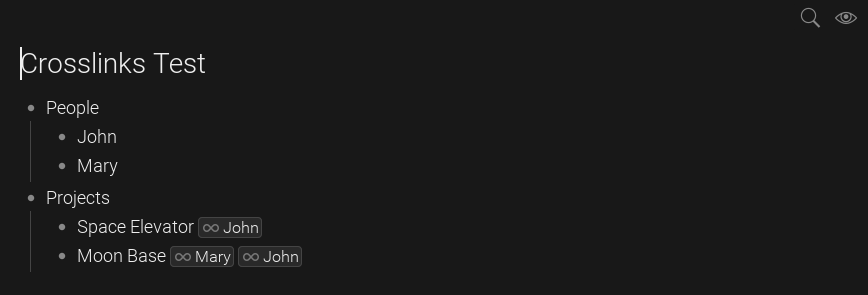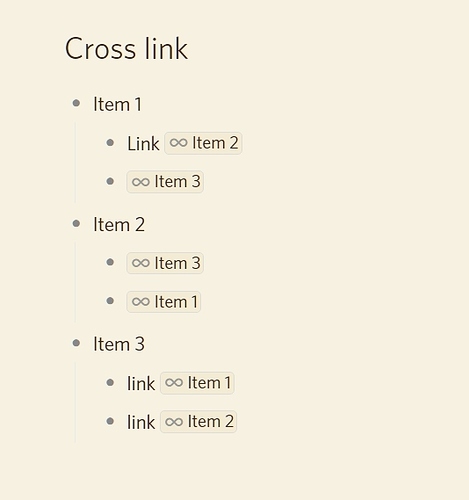I suggest making it possible for Dynalist to create cross-references.
I’ll try to explain with an example. I have an Element1. I add a child Element1 to it with a link to Element2. The Dynalist automatically creates an Element2 child record with a reference to the Element1.
This will make it easier to link different records among themselves.
As an example of use.
I have a list of employees and a list of projects.
When I write in the project “Does John” with reference to John, then John will be automatically added a link to the project that he leads.
Thus, John will get a list of projects that he leads.
PS. Sorry for my English 
I think, it’s not so easy to implement, but it’s a good idea! I use Dynalist in many ways, and this feature would be great for reference bases.
Have you tried invoking internal linking by typing [[? That might do what you want, just not as automatic.
I think, 11113 means, that if you make link from Element 1 to Element 2, Dynalist automaticaly makes backward link from Element 2 to Element 1.
Of course. But my proposal is just to make such links automatic
Not sure how that would look like, since it can be linked by multiple items.
We’ll think about it, thanks!
I think I saw a proposal elsewhere about searches embedded in the tree - like links, but expands to the search result instead. As an alternative to subtree clones.
Would this provide what 11113 asks for? So John’s node could embed at search for #ownedbyjohn
Right now you can sort of find all links to an item by copying this item’s url and searching for it. This surfaces all the links but is not really pleasant to look at.
Suppose you have a document with the following structure:
Then you copy the url of John node and paste it into the search field.
This surfaces the relevant items but sure is a pain on the eyes.
Maybe there could be a special case for searching for item links and the results could look something like this:
There could be an option in the item’s hamburger menu or a keyboard shortcut (not set by default) to find “What links here” for all us people who like crosslinks =).
It looks something like this.
Where is the “link” written - I add.
Where just the link was added automatically.
This idea
Thank you! I did not know about it. But this requires additional efforts. I would like to automation ![]()
So when A links to B, B automatically links back to A somehow, is that correct?
Just wanna make sure I understand it correctly.
Yes, you got it right.
The main thing is that it would be clearly visible visually, without additional effort
Additional effort being what? Does a menu click or a shortcut count too?
If item A is important and you refer to it in 100 places, I imagine you wouldn’t want to see document A to always show the 100 links, right?
We were thinking adding an option so that it automatically searches the URL for you, as a shortcut to the manual work. Not sure if that counts as automatic enough to you?
I would prefer the visual mapping as written above. Or some icon that this element has links from other places.
That is, when I look at the element A, I have to see that it has references from other places
I think that would be the best option to avoid visual clutter. When you click on that icon, for example, all the places it was referenced ![]()
I agree. Interesting solution
I was also surprised that the current linking feature does not offer any back linking, it makes the current feature quite limited. Ideally there should be a way to activate a special button “show linked items” on any node. This would create a clickable child node with a pre-made search query; this search query could then be further edited/refined (e.g to narrow down to nodes in a specific part of the tree, nodes which are checked off, etc).
My example is that I annotated the timeline of a documentary with the different quotes from different people. These link to people which are in a “cast” list. I would like to link back from the different people in this cast list to see the quotes that each person said. Similarly I have other lists like the books which are mentioned in the documentary, institutions, etc. As the documentary is big, automatic back linking is needed to navigate easily.
I would like to add something here…
When you link to an item with [[x]], it links to the item in a document. That means if I move ‘x’ to a different document, all the links pointing to the original location are broken. That means if you try to use a lot of internal linking, you can’t do much reorganizing of your outlines into different documents without problems developing.
A better way to update link locations, or find and replace current links, or even a ‘Find what links here’ function to know what needs to be updated is probably needed in some way.
Related feature request on roadmap: Trello
A hugely valuable feature in linking nodes is the ability to see when a node is linked to from elsewhere at a glance. The currently proposed Trello suggestion of right clicking on a link to search its URL doesn’t solve the issue of being able to immediately tell that a node is linked to. I think the cross-reference feature should make the link style look slightly different than regular, one-way links do so that we can know whether it is even necessary to wast time right-clicking and searching your document for the current node’s URL.
What makes software like TheBrain truly amazing is that you can tell right away that a node is linked to as well as the relationship with the linked-to node (i.e., a parent or child relationship). In my ideal world, Dynalist would provide a symbol to the left of a node that has been linked to, and hovering over that symbol would show the breadcrumbs of the linked node so that there is no reason to waste time searching for links that aren’t there.
The feature still needs a visual indicator of the bullets that are referenced in other places, such as and icon.
Great idea! Would allow progressive filtering, like Roam Research does now, making bidirectional linking that much more powerful.
This is BADLY needed. Internal link breaking is just awful. Also should fix cutting and pasting, including in the same document, which currently breaks internal links and changes created date – NOT how it’s supposed to work.



